March 10, 2024
St. Andrew Church
Rev. Anne McAnelly
4th Sunday in Lent
First Lesson: John 11:43-48, 53
43 When he had said this, he cried with a loud voice, “Lazarus, come out!” 44 The dead man came out, his hands and feet bound with strips of cloth, and his face wrapped in a cloth. Jesus said to them, “Unbind him, and let him go.” 45 Many of the Jews therefore, who had come with Mary and had seen what Jesus did, believed in him. 46 But some of them went to the Pharisees and told them what he had done. 47 So the chief priests and the Pharisees called a meeting of the council, and said, “What are we to do? This man is performing many signs. 48 If we let him go on like this, everyone will believe in him, and the Romans will come and destroy both our holy place and our nation.” 53 So from that day on they planned to put him to death.
Second Lesson: John 11:1-6
Now a certain man was ill, Lazarus of Bethany, the village of Mary and her sister Martha. 2 Mary was the one who anointed the Lord with perfume and wiped his feet with her hair; her brother Lazarus was ill. 3 So the sisters sent a message to Jesus, “Lord, he whom you love is ill.” 4 But when Jesus heard it, he said, “This illness does not lead to death; rather it is for God’s glory, so that the Son of God may be glorified through it.” 5 Accordingly, though Jesus loved Martha and her sister and Lazarus, 6 after having heard that Lazarus was ill, he stayed two days longer in the place where he was.
“We’re a little confused” was the gentle feedback I got after last week’s sermon. I appreciate all feedback; it helps me. So I checked in with Don our experienced teacher. He suggested being Captain Obvious- say it, then say it again and then say it a third time. Here’s your recap.
- Mary Magdalene might mean “Mary the Tower,” not where she is from.
- Who proclaims Jesus the Messiah is important. Peter does in three gospels and the character Martha does it in John.
- The Mary and Martha in Luke, where one serves and the other listens to Jesus choosing the better part, are not related to Lazarus who was raised from the dead.
- Finally, this question about Mary and Martha being the same person, but divided in scripture, is a theory based on what we see in the text. It is being debated, but it is certainly not decided. It is a theory. I invite you to open your Bible and keep it open. We just heard the raising of Lazarus; I will be reading the beginning of that story. John 11:1-6.
Now a certain man was ill, Lazarus of Bethany, the village of Mary and her sister Martha. 2 Mary was the one who anointed the Lord with perfume and wiped his feet with her hair; her brother Lazarus was ill. 3 So the sisters sent a message to Jesus,[a] “Lord, he whom you love is ill.” 4 But when Jesus heard it, he said, “This illness does not lead to death; rather, it is for God’s glory, so that the Son of God may be glorified through it.” 5 Accordingly, though Jesus loved Martha and her sister and Lazarus, 6 after having heard that Lazarus[b] was ill, he stayed two days longer in the place where he was.
John 11 and 12 are the heart of these Mary/Martha discrepancies. Dr. Libbie Schrader Polczer who wrote her thesis about this after studying over 150 manuscripts, found that One in 5 in the Greek and One in 3 in the Latin have variations about Mary and Martha. The text is unstable, that is undeniable. You don’t have to take my word for it, I want to show you the text. You don’t need to read Greek to see the changes. I took these pictures at the conference as Dr. Polczer spoke.
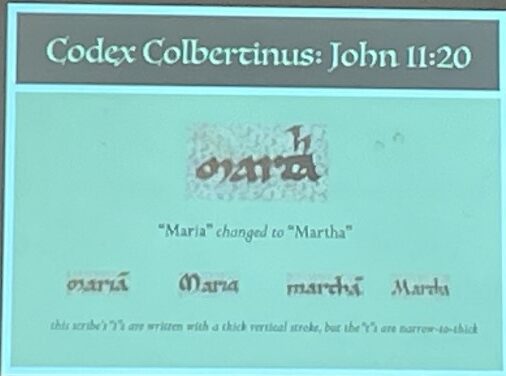
Obvious change of Maria to Martha. This happens later in John 11.
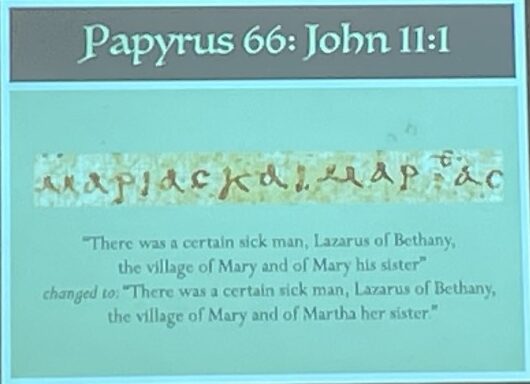
Papyrus 66 is the oldest and most complete text of John. Iota changed to a theta, introducing Martha. Verse two doesn’t change, Mary anoints Jesus.
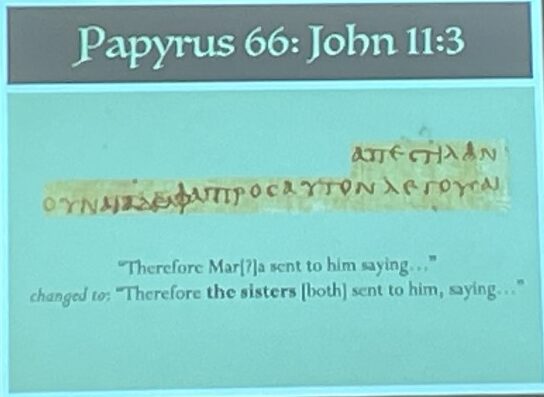
In verse three when talking about who sends the message to Jesus they cram “the sisters” in where Mary was. Verse 4 remains the same and explains the purpose: Lazarus raised from the dead is for God’s glory, so Jesus can be glorified. Remember that! Finally, we are told that this family is important to Jesus. Jesus loves them.
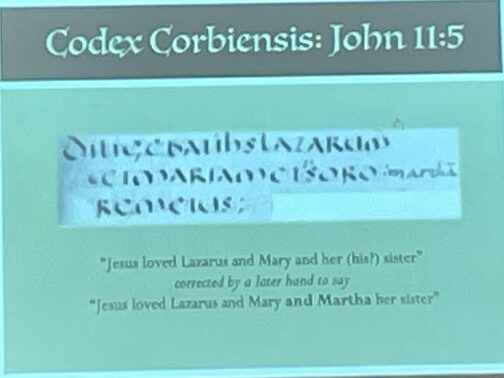
Here we see Martha added off to the side. An afterthought. Let me ask you, in what world would a woman be listed first within a family with a male? Certainly not in the first century. The text says Jesus loves Lazarus and Mary his sister. But our bible says, “Jesus loved Martha and her sister and Lazarus.” How does Martha get to the front of the line? Why was her name added?
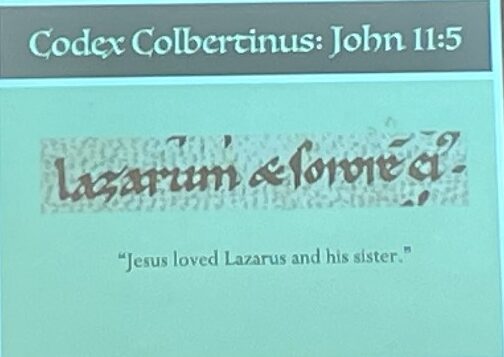
In this text we see, “Jesus loved Lazarus and his sister.” One sister, Mary, Lazarus’ sister. St. Ambrose seemed to know this reading, writing, “In short, Jesus loved Lazarus and Mary: Christ loved his church” (Was Martha of Bethany Added to the Fourth Gospel in the Second Century? Harvard Theological Review 08 September 2016). No mention of Martha. So would this passage make sense if we took Martha out?
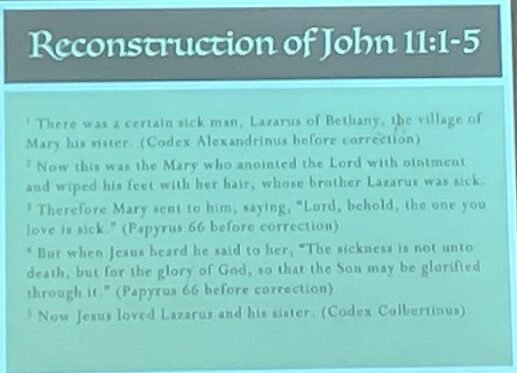
Here is how Dr. Polczer put all these pieces together, showing Mary as Lazarus’s sister. “These was a certain sick man, Lazarus of Bethany, the village of Mary his sister. Now this was the Mary who anointed the Lord with ointment and wiped his feet with her hair, whose brother Lazarus was sick. Therefore Mary sent to him, saying, “Lord, behold, the one you love is sick. But when Jesus heard he said to her, “The sickness is not unto death, but for the glory of God, so that the Son may be glorified through it.” Now Jesus loved Lazarus and his sister.”
A complete account with only one sister.
Have I made the case that Lazarus might have had only one sister named Mary?
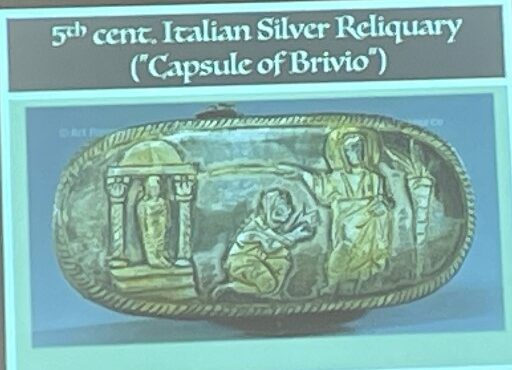
If not, here is art from the 5th cent. showing only one sister. If so, you might be wondering why does this matter? What’s the big deal? The big deal is that many believe that Mary of Bethany, Lazarus’ sister, is Mary Magdalene. The Catholic National Register says, “For centuries, St. Mary of Bethany was considered by many to be the same as Mary Magdalene” (https://www.ncregister.com/blog/mary-of-bethany-chosen-the-better-part). I am going to say that again, for centuries Mary Magdalene was believed to be the sister of Lazarus. Remember Lazarus lived in Bethany and his sister is often called Mary of Bethany. Let that sink in.
Now before we unpack that, I hope you noticed in the first lesson that the raising of Lazarus was the last straw, convincing the Pharisees Jesus was a threat and should be killed. This is the turning point in John. Jesus being proclaimed the Messiah, the Son of God, the One coming into the world, by a woman, possibly by Mary Magdalene. If Martha was added to this text, if Lazarus had only one sister, then the Mary, could be Mary Magdalene who proclaim Jesus the Son of God!
Remember Peter confessed Jesus the Messiah in three gospels. Our Bibles tell us Martha said Jesus is the Messiah. But what if it was Mary Magdalene making this Christological statement in John! Did they want to hide that, so invented a sister Martha? Maybe.
Now before we unpack that, I hope you noticed in the first lesson that the raising of Lazarus was the last straw, convincing the Pharisees Jesus was a threat and should be killed. This is the turning point in John. Jesus being proclaimed the Messiah, the Son of God, the One coming into the world, by a woman, possibly by Mary Magdalene. If Martha was added to this text, if Lazarus had only one sister, then the Mary, could be Mary Magdalene who proclaims Jesus the Son of God!
Remember Peter confessed Jesus the Messiah in three gospels. Our Bibles tell us Martha said Jesus is the Messiah in John. But what if it was Mary Magdalene making this Christological statement! Did they want to hide that, so invented a sister Martha? Maybe.
Diana Butler Bass often says whenever all four gospels tell the same story pay attention, this is important. Mary Magdalene is at the resurrection of Jesus in all four gospels (Mt 28:1-10, Mk 16:9, Lk 24:10, Jn 20:18). Sometimes she is alone and other times she is accompanied by other women. But Mary Magdalene is always there. She even speaks to the risen Lord, after having witnessed the crucifixion in three gospels. Yet little is said about her elsewhere. We know she was healed of seven demons and anoints Jesus in John’s gospel. But why would the risen Jesus appear to Mary Magdalene if she is only a secondary figure? But if she proclaimed him the Messiah, like Peter, then that makes more sense. Her presence at the tomb, her speaking to the risen Lord is because she wasn’t a secondary figure. So why might a scribe want to alter the text in John? Why change Mary to Mary and Martha?
Most scholars agree that Mary Magdalene was a controversial figure. A woman who was close to Jesus. One of the two most influential women in scripture right alongside of Mary Jesus’ mother. Remember the church made these two women polar opposites, with Mary Magdalene wrongfully depicted as a prostitute and Jesus’ mother the Holy Virgin.
So why would a scribe, the church, the powers that be, change the biblical text? At first, I thought it was simply more oppression of women. But it could also be the scribe harmonizing the passage with the Lukan story of Mary and Martha. Dr. Polczer writes, “I believe there is a strong possibility that this change was made in order to hamper the text’s subtle identification of Mary of Bethany with Mary Magdalene, and perhaps in particular to ensure that John 11:27’s crucial Christological confession would not be on her lips” (Was Martha of Bethany Added to the Fourth Gospel in the Second Century? Harvard Theological Review 08 September 2016).
With Martha in the picture, Mary is not professing Jesus as the Messiah!
Without Martha then Mary Magdalene is proclaiming Jesus the Messiah!
Diana Butler Bass concludes her sermon All the Mary’s, which has now been listened to online by over a million people, with this question. “What if the other story of Mary hadn’t been hidden? What if Mary in John 11 hadn’t been split into two women? What if we’d known about Mary the Tower all along? What kind of Christianity would we have if the faith hadn’t only been based upon, “Peter, you are the Rock and upon this Rock I will build my church”? But what if we’d always known, “Mary, you are the Tower, and by this Tower we shall all stand?” I invite you to imagine, imagine that possibility that is opening before us, never visible to our ancestors since that text was first altered … more than a millennia ago. What does that church look like? What does a Christianity of Mary the Tower look like? And what in the world might that towering faith have to say to this moment of crisis in which we live? I do not know the answers to these questions. But what I do know is that all of this matters.” Amen.
